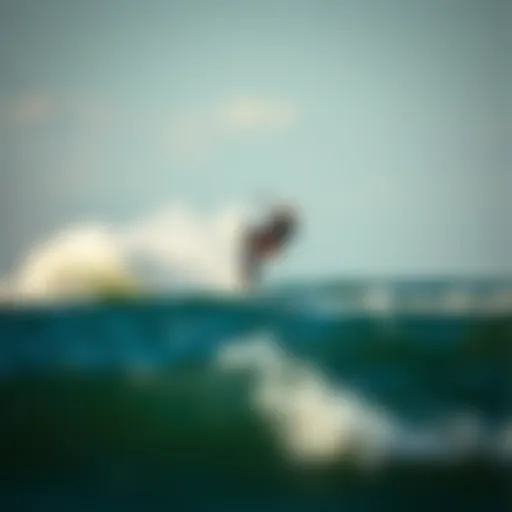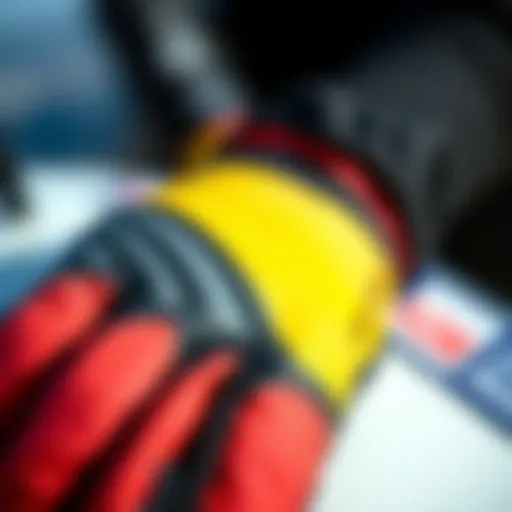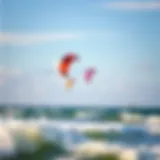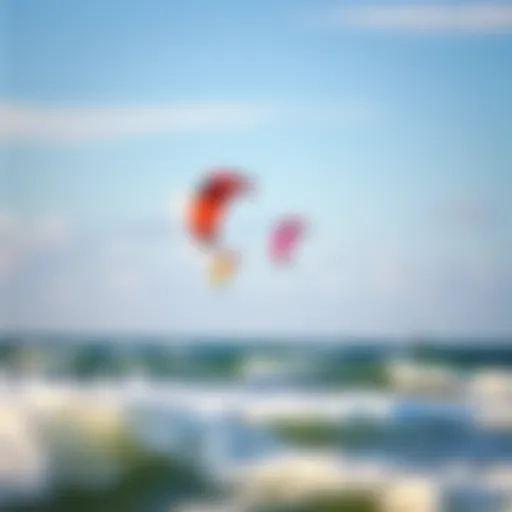Essential Insights for Mastering Kitesurfing
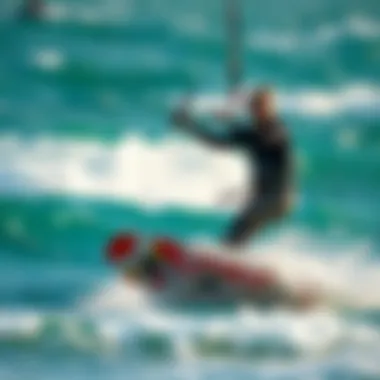

Intro
Kitesurfing is not just about harnessing the wind; it’s about mastering a delicate dance between skill, understanding, and nature. With every gust that lifts the kite into the sky, the kitesurfer embarks on a journey filled with excitement and the lure of the ocean. Learning this sport involves more than just getting your feet wet. It’s a mix of techniques, top-notch equipment, safety know-how, and knowing where to ride to make the most of your adventure.
This guide seeks to demystify kitesurfing for those keen to ride the waves with confidence.
Techniques for Kiteboarding Enthusiasts
Beginner Techniques
Starting out in kitesurfing can feel a bit overwhelming, but breaking it down helps. First, it’s crucial to develop a solid foundation in the basics of kite control. Here’s some steps to get you rolling:
- Understanding the Wind Window: The area in which the kite can fly. You'll want to practice steering the kite in this space, learning to keep the kite in the power zone for the pull needed to get started.
- Body Dragging: This is often the first on-water experience. Let the kite pull you across the water while you’re in the water. It builds familiarity with kite control and helps learn how to stabilize the body and maintain balance.
- Water Start Basic: As your confidence increases, you’ll want to work on standing up on your board. Focus on the timing of the kite’s pull relative to your movements to pop up and ride.
Each of these skills is a vital piece of the puzzle, and nailing them becomes the stepping stone to more advanced maneuvers.
Advanced Maneuvers
Once you get the hang of the basics, the horizon starts expanding. Here, we delve into some advanced techniques that bring a new flair to your riding:
- Jumping: The art of jumping starts with building speed and proper kite positioning. As you learn to pop off the water, you’ll find tremendous freedom in the air.
- Transitions: Navigating turns smoothly keeps the flow. This involves shifting your weight while managing kite control to maintain speed through turns.
- Tricks: Progressing to flips and spins can turn heads. Start with simple rotations, escalating to more complex aerial feats.
Each maneuver opens a new door in your kitesurfing journey, urging you to keep pushing your limits.
Equipment Reviews
Equipment plays a pivotal role in kitesurfing, and choosing the right gear can tremendously affect your experience on the water. Here’s a closer look:
Kite Reviews
Different kites suit various conditions and skill levels. Here are a few recommendations that fit the bill:
- Airush Switch: Excellent for beginner and intermediate riders, providing stability and maneuverability.
- Naish Pivot: Known for versatility, this kite performs well in various wind conditions.
- Duotone Rebel: A classic choice for advanced riders who seek performance and responsiveness.
Selecting the right kite ensures you harness the wind's full potential, translating to smoother rides.
Board Reviews
Your board is how you connect with the water. Consider these options:
- North Trust: Perfect for beginners, it offers great stability and ease of use.
- Slingshot Misfit: Designed for versatile performance, ideal for those looking to expand their skill range.
- Fanatic Gecko: Great for those chasing performance, offering excellent upwind ability and control.
Finding the right board can make a difference in performance, allowing for better control and comfort all through your sessions.
Final Thoughts: Mastering kitesurfing is not a sprint; it’s a marathon. With patience, practice, and the right techniques and equipment, anyone can push the limits of what's possible on the water. The community around kitesurfing is also an invaluable resource, so don’t hesitate to connect with fellow enthusiasts. A supportive network can augment your skills and inspire you on your journey.**
For more resources and community connections, check out Wikipedia, Britannica, or Reddit.
Preface to Kitesurfing
Kitesurfing, often described as flying a kite while gliding over water, combines elements of windsurfing, surfing, and paragliding, making it a unique and exhilarating sport. Understanding kitesurfing is essential not just for enthusiasts but also for instructors and coaches who guide newcomers in this thrilling activity. Mastering kitesurfing requires a deep dive into its core principles, techniques, and safety measures, all of which play a vital role in ensuring an enjoyable experience.
By grasping essential knowledge about the sport, individuals can avoid common pitfalls that beginners often encounter. For instance, understanding how different wind patterns affect kite performance is crucial. It can dramatically shape one's learning curve and overall enjoyment. Those who embrace kitesurfing with the right foundational insights can transition seamlessly from novice to proficient rider.
Being aware of the rich history and evolution of kitesurfing can enhance one’s appreciation for the sport. As kiteboards have advanced, so too has the understanding of the mechanics behind them. This correlation elevates not only the rider’s performance but also the experiences shared within the kitesurfing community.
History and Evolution
Kitesurfing dates back several centuries, with its roots intertwined with various cultures that harnessed wind power for leisure and practicality. The modern kitesurfing phenomenon began to take shape in the late 20th century. In the 1980s and 90s, pioneers like Alex Aguera and the Legaignoux brothers developed inflatable kites that enabled more control and stability on water. This innovation opened the floodgates for kitesurfing, garnering attention across the globe.
Over the years, the sport has not only evolved in equipment design but also in techniques and styles. Freestyle, wave riding, and racing became defining categories, catering to diverse preferences and skill levels. Moreover, the rise of social media and digital platforms allowed for a rapid exchange of knowledge and experiences, accelerating the sport's growth and accessibility to a broader audience.
Understanding the Sport
To truly "get" kitesurfing, one must understand its nuances. It’s not simply about being pulled by a kite across water; it involves harnessing wind, mastering balance, and having an intuitive grasp of the water’s course. Wind conditions are primary factors affecting performance. Understanding how to read and respond to varying strengths and directions of wind can make the difference between a successful session and a frustrating one.
Basic skills like stance and balance are foundational. Riders must learn to position their bodies correctly to maximize the lift from their kites and maintain control over the board. Knowing when to shift your weight and how to manipulate the kite is pivotal, especially when transitioning from smooth water to wave riding.
Engagement with the kitesurfing community offers valuable resources for learning. From local clubs to online forums, shared experiences and tips can help newcomers bypass common mistakes. Also, aspiriing kitesurfers can benefit greatly from instructor-led training, which provides structured learning environments tailored to different skill levels.
The Mechanics of Kitesurfing
Understanding the mechanics behind kitesurfing is vital for anyone looking to master this exhilarating sport. These mechanics are not merely about how to fly a kite or maneuver a board; they encompass the principles of physics at play, the relationship between wind and water, and how these factors combine to create an exhilarating ride. By grasping these elements, novice and seasoned kiteboarders alike can level up their performance, reduce the risk of accidents, and enjoy the sport to its fullest.
How Kites Function
Kites operate on fundamental aerodynamic principles. When the wind flows over the kite’s surface, it generates lift, allowing the kite to soar above the water. The angle at which the kite holds against the wind and the size of the kite can drastically change the amount of lift produced.
- Types of Kites: There are various types you can choose from: inflatable kites, which are the most common due to their durability and ease of use; and foil kites which are lightweight and provide excellent performance for experienced riders.
- Kite Control: Mastering kite control is crucial. This means learning to steer the kite with your hands while managing the tension on the lines connected to your harness. When you pull on one side of the control bar, the kite turns in that direction; pushing the bar away can also help reduce power when the wind gets stronger.
- Wind Window: Kitesurfers often talk about the wind window, which is a three-dimensional space in which the kite can fly. Understanding this helps in positioning the kite to generate the right amount of power for various maneuvers. Depending on the direction and strength of the wind, the kite's position within this window will determine how well it performs.
"The wind doesn’t just help the kite fly; it creates a dialogue with the rider’s instinct and skill. Understanding this language is essential to becoming a proficient kitesurfer."
Wind Conditions Explained
Wind is an unchangeable force in kitesurfing, and its understanding is crucial for a safe and enjoyable experience. Not all wind is the same, and recognizing its various conditions can make or break a session.
- Wind Strength: This plays a pivotal role. Light winds need smaller kites, while stronger winds require larger kites for balance and control. Being aware of local weather forecasts and patterns can help kiteboarders use the optimal gear.
- Consistent Winds: A steady wind is better than unpredictable gusts. Gusty conditions can lead to abrupt power surges that may cause loss of control. Therefore, it’s always wise to seek locations known for their consistent wind.
- Wind Direction: Different wind directions affect how waves form and interact with the shore. Cross-shore winds, which blow parallel to the beach, are generally ideal for kitesurfing as they facilitate smooth take-offs and landings.
In learning to interpret wind conditions, you'll find not just safety and skill improvement, but also a deeper connection with the nature that surrounds you while kitesurfing.
Fundamental Techniques
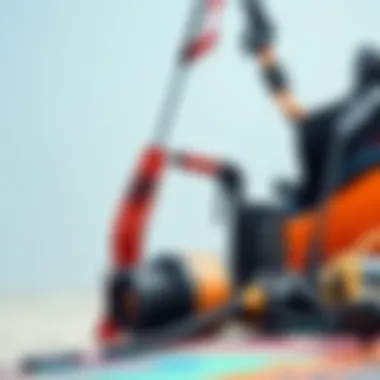

Mastering the fundamental techniques of kitesurfing is the bedrock of becoming a proficient rider. These techniques lay the groundwork for every aspect of the sport, whether you are just stepping into the water or gearing up to perform complex aerial tricks. Without a solid grasp of these fundamentals, the thrill of kitesurfing can quickly turn into a precarious endeavor.
Fundamental techniques enhance not just your skill but also your confidence on the board. They include everything from your stance to how you control the kite. Understanding these techniques can dramatically improve your performance and keep you safe in various conditions.
Beginner Skills to Master
Stance and Balance
Getting your stance right creates a stable base for everything else that follows in kitesurfing. Think of it as your foundation. A good stance ensures you maintain balance while riding over the water, which is key for future progression.
The most effective stance usually involves bending your knees slightly and keeping your feet shoulder-width apart. This means you’re low and ready, much like a sprinter at the starting line. The key characteristic here is the adaptability of your stance; if the wind picks up or if you face choppy conditions, a well-adjusted stance helps manage the unexpected.
Many beginners find this stance advantageous. The lower center of gravity improves stability, minimizing the risk of falls. However, there's a fine balance to strike here—too rigid a stance can lead to stiffness and hinder agility.
Starting Your First Ride
Starting your first ride is one of those moments that truly defines your entry into the world of kitesurfing. It’s the transition from preparation to action, where the thrill really kicks in. The critical aspect is the way you harness the kite’s power to pull you across the water.
A proper initial ride often emphasizes the key characteristic of timing. You want to ensure that your kite is positioned correctly, usually at the edge of the window, to catch the wind effectively. This gives you the pull that’s required to get up on your board.
Starting off can feel a bit overwhelming, but it’s a richly rewarding experience when you finally glide along the surface. The unique feature of this skill lies in the moment of freedom it provides, yet it can be tricky if you don’t respect the power of the kite. Landing face-first on the water is part of the learning curve.
Controlling the Kite
Learning to control the kite is one of the vital skills that underpins success in kitesurfing. It’s not just about keeping it in the air; it’s about mastering its movements in relation to both your board and the wind conditions.
The key characteristic of effective kite control is both finesse and responsiveness. You need to learn how to make subtle adjustments based on changing wind forces. Efficient kite control means that you can harness the power of the kite to get the lift you need to perform tricks or merely maintain balance.
A unique feature here is the ability to use the kite’s movements not only to propel you forward but also to perform various maneuvers. Missing out on mastering this can result in a frustrating experience on the water. A kite that is badly controlled can pull you off balance or, in worst-case scenarios, lead to an accident.
Advanced Maneuvers
Once the basics are down, riders aspire to take their kitesurfing skills to the next level through advanced maneuvers. This not only showcases the progression of talent but also offers a new layer of excitement and challenge.
Jumping Techniques
Jumping techniques are a hallmark of advanced kitesurfing. They enable riders to elevate themselves above the water, sometimes to astonishing heights. This skill is not just about the leap; it also requires a well-timed pull on the bar combined with a proper takeoff angle.
The key characteristic of jumping is timing your kite's lift in relation to your speed and control of the board. Many riders find this technique to be incredibly rewarding, providing a sense of freedom and adrenaline rush.
However, jumping can also pose risks if executed improperly. The unique feature of jumps lies in their complexity, covering not just upwards motion but also landing safely. Navigating the landing requires skill; misjudgment can lead to splashes rather than smooth landings.
Transitioning Smoothly
Transitioning smoothly between different directions while riding is crucial for maintaining momentum. It is often overlooked but can significantly enhance your overall riding style.
The key characteristic of a smooth transition is its fluidity. Riders who can transition without losing speed or balance often appear more experienced. In a practical sense, this skill offers an array of options; you can change your direction quickly and creatively.
A unique aspect of smooth transitions is that they allow you to link tricks together, adding a level of sophistication to your repertoire. While it may seem simple at first glance, mastering this technique requires practice and focus; otherwise, you risk losing speed and control.
Freestyle Tricks
Freestyle tricks can be the crown jewel of any kitesurfing experience. They encapsulate creativity and skill, pushing the boundaries of what can be achieved on the water. Tricks like spins, flips, and grabs can leave spectators in awe.
A key characteristic of freestyle kitesurfing is its focus on creativity. Riders express themselves through unique maneuvers, often reflecting individual style and personality. This can be a popular choice for many because each trick tells a story of improvement.
However, the unique features of freestyle tricks also bring challenges. These tricks require not just a solid understanding of the fundamentals but also an unwavering commitment to practice and perseverance. Mistakes can be costly, but the rewards of nailing a tough trick are monumental.
"Kitesurfing isn't just about riding the waves; it's about mastering your elements and expressing your passion."
By mastering these fundamental techniques, from balancing on your board to performing freestyle tricks, a kitesurfer can transition from a novice to an accomplished rider, ready to tackle any challenge presented by the waves.
Essential Equipment
The right equipment is crucial in kitesurfing, influencing not just performance but also safety and enjoyment. Engaging with the sport means you’ll want to understand what to look for when picking out gear. This section dives into two primary pieces of equipment every kitesurfer needs: the kite and the board. Grasping the ins and outs of these can elevate your experience on the water.
Choosing the Right Kite
Selecting the perfect kite can make or break your adventure on the waves. A kite's size and type significantly affect your ability to harness the wind, impacting your speed, lift, and overall ride.
Kite Sizes and Types
Kites come in various sizes, each suited for different wind conditions and rider preferences. Usually, smaller kites excel in high winds, while larger ones are better for lighter breezes. The key characteristic of kite size is its surface area, which directly correlates with how much wind the kite can capture.
- Performance Factor: A larger kite can provide more lift, making it easier for beginner kitesurfers to get off the ground.
- Drawback: On the flip side, too large of a kite in strong winds can result in uncontrollable situations.
Different types of kites include C-kites, bow kites, and delta kites, each featuring unique attributes best suited for various riding styles. C-kites, for instance, are excellent for advanced tricks but may be less forgiving for novices.
Materials and Durability
Kite construction is often overlooked but vital for an enjoyable session on the water. Kites made from durable materials can handle wear and tear better, ensuring that you can rely on your equipment for numerous sessions.
- Benefits: Look for materials like ripstop nylon, which combines lightweight properties with resistance to tears.
- Consideration: While high-durability materials may come at a higher price point, this investment pays off, thanks to longevity.
Each kite’s construction also impacts its performance in the water. The right materials can provide better responsiveness and longevity, keeping your sessions rip-free and worry-free.
Safety Features
When it comes to kitesurfing, safety should always be top of mind. A kite equipped with reliable safety features can be a lifesaver in challenging situations.
- Key Characteristics: Look for kites that have emergency release systems and stable flying characteristics, which can prevent accidents.
- Advantages: These features give peace of mind, especially for those just starting their kitesurfing journey.
For instance, a well-designed kite with effective depower capabilities allows riders to easily manage the kite in unexpected gusts, ensuring a safer ride overall.


The Board: Basics and Variations
The board is another central piece of equipment that plays a significant role in how you navigate the water. Understanding the differences between board types can significantly enhance your performance.
Directional vs. Twin-Tip Boards
When choosing a board, you’ll face a choice between directional and twin-tip boards. Each serves different purposes in kitesurfing.
- Directional Boards: These are intended for riding in one direction. They work well in surfing conditions and provide stability.
- Twin-Tip Boards: More common among beginners, twin-tip boards are symmetrical, allowing for riding in either direction.
Both types have their pros and cons. Directional boards can offer a smoother ride through chop but require more skill to control. Twin-tip boards are user-friendly, making them a great choice for learners who want to progress quickly.
Board Dimensions
Board dimensions impact performance significantly. They affect speed, floatation, and maneuverability.
- Key Characteristic: Wider boards provide more stability, especially for beginners, while narrower boards increase ease in turns and jumps.
- Important Note: The choice of dimensions often weighs against expected riding style and body weight.
In general, a wide board is ideal for lighter winds, as its larger surface area allows for better lift, whereas a narrow board might be preferred in stronger winds where fast turns are more critical.
Design Choices
The design of a board isn’t just about looks; it plays a role in overall performance. Different designs offer varying levels of grip and flow through the water.
- Key Attributes: Custom designs may include concave bottoms for better water flow or rocker profiles to help with smooth landings.
- Benefits: Choosing a design that complements your riding style can enhance comfort and performance during your sessions.
A board that harmonizes with your riding style not only enhances your skills but also ensures an engaging kitesurfing experience, making it possible to enjoy the thrill of every ride.
Remember: Whether you’re picking a kite or a board, always think about your skill level and the conditions you'll be riding in. Choosing wisely can make a big difference.
Safety Considerations
Understanding the risks involved in kitesurfing is crucial for enthusiasts at any level. Safety considerations are not just an afterthought; they are foundational to many successful rides on the water. This section dives into the hazards and gear necessary to ensure that you enjoy your kitesurfing experience while minimizing risks. By being aware of potential dangers and investing in the right equipment, you set yourself up to ride the waves with confidence.
Understanding Hazards
Identifying Dangerous Conditions
When preparing to hit the water, recognizing dangerous conditions is paramount. These hazards could range from high winds to sudden weather changes, or even crowded beaches. Understanding how to read the conditions can greatly enhance your safety. For instance, if the wind suddenly switches direction or increases in strength, this can indicate an impending storm. Key characteristics such as local wind patterns and water currents make it essential to check the forecast before heading out. This not only helps in making an informed decision but can also be life-saving.
The unique feature of keeping an eye on these conditions is that they can change rapidly. A seemingly calm sea can transform in no time, which can create a precarious situation for an unprepared rider. Learning to identify these signs can protect you and also others in your vicinity. Taking a couple of minutes to assess your environment before taking the plunge can make all the difference.
Potential Injuries
Kitesurfing, while exhilarating, isn’t without its risks. Understanding potential injuries, such as sprains, fractures, or even more serious accidents like bruises or concussion, is essential for all kitesurfers. An important aspect of this topic is that kitesurfing injuries often arise from misjudging conditions or improper technique, which are frequent across all levels of experience. The prospect of injury is often a deterrent for newcomers, yet knowing and preparing for these risks can ease many fears.
The uniqueness of assessing potential injuries lies in the proactive approach it encourages. Learning proper form, understanding the importance of warm-ups, and practicing falls can significantly reduce the risk of serious injury. Moreover, being aware of the most common injuries and how to prevent them contributes immensely to a safer kitesurfing experience.
Safety Gear Requirements
Investing in appropriate safety gear isn't just about being compliant with community standards; it’s also about ensuring your own safety. Quality gear can be the difference between a mild mishap and a serious accident. Therefore, focusing on the necessary safety equipment is imperative for anyone serious about participating in kitesurfing.
Impact Vests
Impact vests serve a critical role by safeguarding your core during water sports. While they might not prevent all injuries, their padded construction is key in absorbing shock from falls or when coming in contact with the water. They're an essential piece of equipment for riders looking for both freedom of movement and added protection. One unique feature of modern impact vests is their lighter weight and superior design, which allows for greater flexibility without compromising on safety.
The advantages of wearing an impact vest far outweigh the discomfort that some riders might initially feel. Not only do they enhance safety during high-speed attempts, but they also provide buoyancy — an often overlooked benefit that can assist in staying afloat.
Helmets
Helmets are another vital piece of equipment for kitesurfers, particularly in areas with numerous obstacles or heavy traffic. They protect the head from impacts that could occur while riding, as well as accidents during falls. The primary characteristic of helmets designed for kitesurfing is their specific design for water sports, which often include a secure fit and water drainage features to prevent them from becoming waterlogged.
The uniqueness of helmets lies in their ability to inspire confidence. When you feel protected, you’re more likely to push your limits and improve your skills. However, it's critical to select helmets designed for kitesurfing, as generic sport helmets may lack the necessary durability and water-resistance suited for the sport's unique challenges.
Safety Leashes
Safety leashes play a significant role in ensuring that your kite remains tethered to you, even in turbulent conditions. Should you find yourself separated from your kite, which is not uncommon in less favorable wind gusts, a good safety leash helps prevent the kite from taking off uncontrollably. The key advantage here is the security it provides; it can significantly reduce the risk of your kite drifting away and causing potential dangers to other water users.
What sets safety leashes apart from regular leashes is their emergency release mechanism, which permits a quick disconnect if necessary. However, it’s important to maintain and inspect them regularly, as wear and tear can compromise effectiveness. Using reliable gear is vital, highlighting that while you may be an experienced kitesurfer, having the right safety equipment can make all the difference.
Finding the Best Locations
Finding the right spot to kitesurf is of utmost importance. Not only does it affect your overall experience, but it also plays a big role in your safety and chance of improvement. The ideal location can provide consistent wind, manageable waters, and even some friendly faces cheering each other on. Let's explore some options that every kitesurfer should consider to fuel their passion.
Top Global Destinations
Ocean Beaches
Ocean beaches are often the first choice for kitesurfers. They offer vast areas of open water and usually, reliable wind patterns. One of the key characteristics of ocean beaches is the variety of wave sizes. This feature allows kitesurfers from different skill levels to enjoy themselves. Beginners can practice their balance in smaller waves while seasoned riders can push their limits in more challenging conditions.
The beauty of ocean beaches isn't just in their scenery. The mix of saltwater and wind creates unique opportunities for maneuvers and jumps. However, there are some disadvantages to consider as well. The water may be less predictable than lakes, with currents and tides that change the environment rapidly. This means that keeping an ear to the ground about local conditions is crucial before heading out.
Lake Spots
Lake spots have been gaining traction in the kitesurfing community for good reasons. Typically, these environments offer flatter waters ideal for beginners or those mastering tricks. One key feature of lakes is their relative stability. Many lakes have steady wind patterns that remain consistent on most days. That predictability is what makes them a favored spot for many.
Moreover, lakes often have a calmer atmosphere compared to ocean beaches, making it a more relaxed environment. However, one should keep in mind that lakes may lack the exuberance of ocean waves. While you won't be doing any big jumps, it is perfect for fine-tuning your skills. Being mindful of any local regulations is also important since these spots may have more stringent usage rules.
Wind Conditions Analysis
Wind conditions are arguably the most critical element in choosing a location. Understanding how to read and analyze wind conditions can make or break a kitesurfing session. A solid spot should ideally have a reliable wind direction, consistent speeds, and minimal gusts. This part of your location analysis is vital not only for enjoyment but also for safety.
For every kitesurfer, monitoring tools such as weather apps or sites dedicated to wind conditions can be lifesavers. They help you gather information about both current and predicted wind speeds. A location with great wind but full of obstructions can lead to hazardous situations, so it's worth checking both the wind and the surroundings before you hit the water.
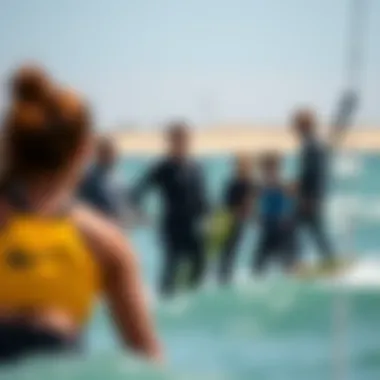

Local Kitesurfing Communities
Joining Local Clubs
Engaging with local kitesurfing clubs can greatly enhance your experience on the water. Clubs often provide invaluable support, equipment, and community. When joining a local club, members usually share tips, local knowledge, and occasionally organize social gatherings. This environment can be particularly beneficial for newcomers trying to figure out their footing in the sport.
A unique feature of these clubs is their ability to organize events that can expose you to kitesurfing culture and new friends. However, sometimes they may have membership fees, which can be a downside to those on a budget. Overall, being part of a club fosters camaraderie and can definitely elevate your skills as you learn from your peers.
Participating in Events
Participating in kitesurfing events can be exciting and rewarding. These competitions provide a chance to witness advanced techniques, gaining insights and inspiration. They can also serve as an excellent platform for networking with other kitesurfers who share your passion.
The events may vary from friendly meetups to serious competitions, allowing kitesurfers of all levels to join in. A unique aspect of these competitions is the sheer energy they create. However, it’s crucial to keep in mind that competing may add pressure, especially if you’re still learning. Don’t forget, though, that the camaraderie and support from fellow participants can turn an intense day into a memorable experience.
Learning to navigate the rigors of events can sharpen your skills and improve your confidence in the water. Always remember to soak in the experience beyond the results.
Learning Resources
In the fast-paced world of kitesurfing, learning resources stand as a crucial pillar to mastering the sport. From ensuring that you're equipped with the right techniques to understanding the myriad of equipment options, these resources open doors to knowledge that can accelerate your progress on the water. Having the right learning tools can greatly enhance your confidence, whether you're a novice preparing for your first ride or an experienced kiteboarder looking to refine advanced maneuvers.
The beauty of kitesurfing lies not only in the thrill of gliding over the waves but also in the continuous learning that comes with it. Effective learning resources allow enthusiasts to access diverse techniques and insights that lay the groundwork for skill development. They also facilitate self-paced learning, giving you the freedom to explore at your own rhythm.
Online Tutorials and Courses
With the internet at our fingertips, online tutorials and courses have surged in popularity. These resources offer a blend of visual demonstrations and detailed explanations which can be vital when learning kitesurfing. You can find platforms like Udemy or YouTube that are brimming with content, ranging from beginner tips to advanced tricks. The major advantage here is flexibility; you can learn whenever it suits you, pause, rewind, and revisit difficult techniques until you feel confident.
However, it is important to choose reputable sources. Poorly crafted content can lead to misunderstandings or even safety issues if done incorrectly. Therefore, spending some time finding high-quality tutorials from recognized kiteboarding experts or associations is worth it.
Instructor-Led Training
While online resources can be valuable, many aspiring kitesurfers find instructor-led training to be an essential part of their journey. Learning in a structured environment with guidance can significantly enhance the learning process. An experienced instructor can provide immediate feedback, pointing out mistakes that might go unnoticed in a self-taught environment.
Choosing the Right School
Selecting an appropriate kitesurfing school is pivotal for ensuring a solid foundation in the sport. Look for schools that have established credibility within the community. A good school often has a host of seasoned instructors who can tailor the training to suit individual needs. Check reviews on platforms like Google or travel forums such as TripAdvisor to identify schools with a positive track record.
One of the key characteristics of a commendable school is their focus on safety. They should prioritize educating students about hazards and implementing proper safety measures. Another significant feature is diversity in teaching methods, catering to various learning styles, whether you prefer hands-on instruction or theory-focused sessions.
"The right school offers both knowledge and safety, building a solid base that translates into confidence on the water."
Inspection of Instructors' Credentials
The credentials of your instructor can greatly impact your kitesurfing journey. Make sure to verify their qualifications and certifications. An instructor affiliated with recognized organizations adds a layer of credibility to their teachings. These associations not only assure a certain standard of training but also showcase a commitment to continual education in the evolving world of kitesurfing.
A highly-qualified instructor often brings significant advantages. They are more likely to have experience with various learning paces and have accumulated tricks and techniques that can be beneficial for students to learn from. However, this often comes with a higher price tag, and one should weigh the benefits of expert instruction against the budget. Ultimately, a well-trained instructor can make a notable difference, fostering a more profound understanding of the sport and helping you avoid common pitfalls.
The Kitesurfing Community
The kitesurfing community is more than just a collection of individuals sharing a passion for the sport. It's a rich tapestry woven from diverse experiences, backgrounds, and cultures. Engaging with this community can significantly enhance your kitesurfing journey for several key reasons: it fosters a sense of belonging, provides shared knowledge and tips, offers safety advice, and promotes a spirit of camaraderie. Connecting with others who share your passion can be a game changer, especially for newcomers trying to navigate the complexities of the sport.
Connecting with Fellow Enthusiasts
Building connections with fellow kitesurfers can enrich the experience in both practical and emotional aspects. Locating the right spots to ride, understanding the prevailing winds, or sharing thrilling stories of adventures create bonds that are hard to find just anywhere.
In many cases, these networks sprout up at local beaches or through social media groups, where enthusiasts regularly help each other. Whether you are asking for feedback on techniques or just geeking out over gear, these interactions can be instrumental. You may even find a buddy for those weekend adventures, which can level up your skills quickly.
Participating in Competitions
Competing in kitesurfing events can inspire growth and push boundaries, but there are pros and cons to consider.
Pros and Cons of Competitions
Pros: Among the most significant benefits of participating in competitions is the motivation it brings to hone skills. Competitions often feature varied challenges, encouraging riders to step up their game and explore new tricks or maneuvers they may not have attempted otherwise. The rush from the competitive environment can indeed boost your performance.
Cons: On the flip side, competition can also induce pressure. Not every kitesurfer thrives in a high-stress atmosphere. Some find that the heightened stakes can sap the joy out of the sport, turning what was once a leisurely pastime into a source of anxiety. Additionally, competitions can favor those who have higher financial support for gear, potentially skewing results.
In essence, deciding whether to compete boils down to personal preference. If you thrive on adrenaline and challenges, competitions might feel like a natural outlet. Conversely, if you cherish the breezy freedom of kitesurfing, an intensely competitive environment might not suit you.
Adventure Challenges
Adventure challenges offer a different yet equally stimulating avenue within the kitesurfing community. These challenges often take participants to remote or unique locations, encouraging adventurers to seek out undiscovered waters and test their skillsets in new conditions. The essence of adventure challenges lies in exploration, pushing the limits of comfort and skill.
One distinctive feature here is the awesome variety. From long-distance races to thrill-seeking expeditions, there is always something new to experience. It allows riders to step outside the routine and be part of something larger.
However, engaging in such challenges does carry its risks. Navigating unfamiliar waters without adequate preparation can lead to unforeseen complications. Being aware of changing weather conditions and having proper safety gear is vital when taking on these adventures. It's essential to have a solid understanding of your capabilities and limitations.
Culmination and Future Perspectives
Kitesurfing is more than just a sport; it's a lifestyle that brings together thrill and tranquility on the water. As one navigates through the waves, it becomes clear how important it is to reflect on the journey and consider where this exhilarating sport is headed in the future. The dual focus on personal growth and community development can provide kiteboarders, instructors, and coaches with a robust framework for continual engagement and improvement in their kitesurfing pursuits.
Reflecting on Your Journey
Taking a moment to reflect on your progression in kitesurfing can be quite enlightening. Each session on the water may present its own challenges and triumphs. Consider the following points while reflecting:
- Skill Development: Think back to when you first started. The early days of learning to control the kite and adjusting to the board can sometimes feel like chasing your tail. But with regular practice, your skills have undoubtedly sharpened.
- Experience Sharing: Engaging with fellow enthusiasts can enrich your understanding. Have you shared your experiences with others? Whether it's the satisfaction of performing a trick or the frustration of a wipeout, sharing those moments can solidify the bonds within the kitesurfing community.
- Setting New Goals: What’s next for you? Setting achievable goals not only motivates but helps keep the flame of enthusiasm alive. Maybe it's mastering a new maneuver, exploring a different location, or even competing.
Focusing on personal milestones helps keep the passion flowing and encourages others to do the same.
The Future of Kitesurfing
As the sport of kitesurfing continues to evolve, several trends can be observed that hint at its bright future.
- Eco-Friendly Materials: Many brands are moving toward sustainable practices in their product lines. Equipment fashioned from eco-friendly materials could be the standard soon. A step that not only benefits the sport but the environment as well.
- Technological Advancements: Innovations in kites, boards, and safety gear keep emerging. Anticipate smarter gear equipped with safety alarms and performance trackers, making the sport safer and more accessible.
- Global Reach: Kitesurfing is gaining popularity worldwide. With more countries recognizing and promoting kitesurfing spots, the opportunities for adventures are becoming limitless. Traveling for kitesurfing will not just be about finding the best winds; it’s also about embracing diverse cultures and experiences.
"The wind and the waves are always changing, but your love for the sport should remain as steadfast as the horizon."
For more detailed discussions on safety measures and gear, visit sources like Britannica or dive into community discussions on Reddit.
Embrace the ride!





